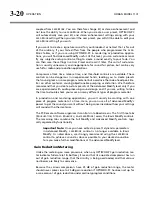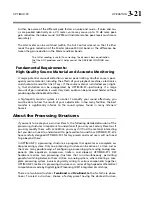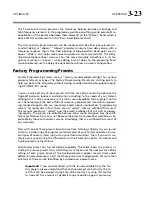
OPTIMOD-PC
OPERATION
3-13
sound of an Orban analog parametric. They also use very high quality filter algo-
rithms to ensure low noise and distortion.
OPTIMOD-PC HF Enhancer is a program-controlled HF shelving equalizer that intelli-
gently and continuously analyzes the ratio between broadband and HF energy in
the input program material. It can equalize excessively dull material without over-
enhancing bright material. It interacts synergistically with the five-band compressor
to produce sound that is bright and present without being excessively shrill.
Multiband Compression:
The multiband compressor can be operated in five-band
or two-band mode. Several band-coupling controls allow the gain reduction of a
given band’s compressor to be partially controlled by the gain reduction in its
neighboring band’s compressor. These coupling controls allow anything from quasi-
wideband compression to fully independent multiband compression.
A clipper, embedded in the crossover, protects bands 1 and 2 from transient over-
shoot. This clipper has a shape control, allowing you to vary the “knee” of its in-
put/output transfer curve from hard (0) to soft (10) (see
Low-IM Look-Ahead Limiter:
The 1101’s peak limiter prevents overshoots by ex-
amining a few milliseconds of the unprocessed sound before it is limited. This way
the limiter can anticipate peaks that are coming up. The limiter’s sidechain is over-
sampled to 192 kHz to prevent significant overshoot from occurring after sample
rate conversion or D/A conversion.
Look-Ahead Limiting and Low Bitrate Codecs:
It is important to minimize audible
peak-limiter-induced distortion when one is driving a low bitrate codec because
one does not want to waste precious bits encoding the distortion. Look-ahead
limiting can achieve this goal; hard clipping cannot.
One can model any peak limiter as a multiplier that multiplies its input
signal by a gain control signal. This is a form of amplitude modulation.
Amplitude modulation produces sidebands around the “carrier” signal. In
a peak limiter, each Fourier component of the input signal is a separate
“carrier” and the peak limiting process produces modulation sidebands
around each Fourier component.
Considered this way, a hard clipper has a wideband gain control signal
and thus introduces sidebands that are far removed in frequency from
their associated Fourier “carriers.” Hence, the “carriers” have little ability
to mask the resulting sidebands psychoacoustically. Conversely, a look-
ahead limiter’s gain control signal has a much lower bandwidth and pro-
duces modulation sidebands that are less likely to be audible.
Simple wideband look-ahead limiting can still produce audible inter-
modulation distortion between heavy bass and midrange material. The
look-ahead limiter in your Optimod uses sophisticated techniques to re-
duce such IM distortion without compromising loudness capability.
Dialnorm and Limiting:
The 1101 supports the dialnorm metadata value in Dolby
Digital® transmissions to the consumer. When used to process a Dolby Digital
transmission, the 1101 can be easily set up to ensure that the loudness of your
Содержание Optimod-PC 1101
Страница 4: ......
Страница 14: ......
Страница 121: ...OPTIMOD PC OPERATION 3 1 Section 3 Operation Figure 3 1 The OPTIMOD PC Control Application...
Страница 192: ...3 72 OPERATION ORBAN MODEL 1101...
Страница 204: ......
Страница 210: ......
Страница 212: ...5 2 UNINSTALLATION ORBAN MODEL 1101...
Страница 236: ......
















































